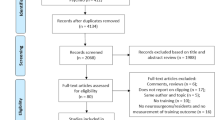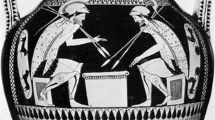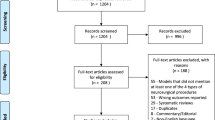Abstract
Background
Currently available simulators are supposed to allow young neurosurgeons to hone their technical skills in a safe environment, without causing any unnecessary harm to their patients caused by their inexperience. For this training method to be largely accepted in neurosurgery, it is necessary to prove simulation efficacy by means of large-scale clinical validation studies.
Methods
We correlated and analysed the performance at a simulator and the actual operative skills of different neurosurgeons (construct validity). We conducted a study involving 92 residents and attending neurosurgeons from different European Centres; each participant had to perform a virtual task, namely the placement of an external ventricular drain (EVD) at a neurosurgical simulator (ImmersiveTouch). The number of attempts needed to reach the ventricles and the accuracy in positioning the catheter were assessed.
Results
Data suggests a positive correlation between subjects who placed more EVDs in the previous year and those who get better scores at the simulator (p = .008) (fewer attempts and better surgical accuracy). The number of attempts to reach the ventricle was also analysed; senior residents needed fewer attempts (mean = 2.26; SD = 1.11) than junior residents (mean = 3.12; SD = 1.05) (p = .007) and staff neurosurgeons (mean = 2.89, SD = 1.23). Scoring results were compared by using the Fisher’s test, for the analysis of the variances, and the Student’s T test. Surprisingly, having a wider surgical experience overall does not correlate with the best performance at the simulator.
Conclusion
The performance of an EVD placement on a simulator correlates with the density of the neurosurgical experience for that specific task performed in the OR, suggesting that simulators are able to differentiate neurosurgeons according to their surgical ability. Namely this suggests that the simulation performance reflects the surgeons’ consistency in placing EVDs in the last year.



Similar content being viewed by others
Abbreviations
- ACGME:
-
Accreditation Council of Medical Education
- CT:
-
Computed tomography
- EVD:
-
External ventricular drain
- ENSSG:
-
European Neurosurgery Simulation Study Group
- EWTD:
-
European Working Time Directive
- OR:
-
Operative room
- PGY:
-
Post graduate year
References
Datta ST, Davies SJ (2015) Training for the future NHS: training junior doctors in the United Kingdom within the 48-hour European working time directive. BMC Med Educ. https://doi.org/10.1186/1472-6920-14-S1-S12
Ganju A, Aoun SG, Daou MR, El Ahmadieh TY, Chang A, Wang L, Batjer HH, Bendok BR (2013) The role of simulation in neurosurgical education: a survey of 99 United States neurosurgery program directors. World Neurosurg https://doi.org/10.1016/j.wneu.2012.11.066
McCall T, Rao G, Kestle J (2005) Work hour restrictions: impact on neurosurgical resident training at the University of Utah. AANS Bull 14(4):17–23
Kirkman MA, Ahmed M, Albert AF, Wilson MH, Nandi D, Sevdalis N (2014) The use of simulation in neurosurgical education and training. J Neurosurg. https://doi.org/10.3171/2014.5.JNS131766
Yiasemidou M, Glassman D, Tomlinson J, Song D, Gough MJ (2017) Perceptions about the present and future of surgical simulation: a National Study of mixed qualitative and quantitative methodology. J Surg Educ. https://doi.org/10.1016/j.jsurg.2016.07.011
Lewis TM, Aggarwal R, Kwasnicki RM, Rajaretnam N, Moorthy K, Ahmed A, Darzi A (2012) Can virtual reality simulation be used for advanced bariatric surgical training? Surg (United States). https://doi.org/10.1016/j.surg.2012.03.014
Gelinas-Phaneuf N, Choudhury N, Al-Habib AR, Cabral A, Nadeau E, Mora V, Pazos V, Debergue P, Diraddo R, Del Maestro RF (2014) Assessing performance in brain tumor resection using a novel virtual reality simulator. Int J Comput Assist Radiol Surg https://doi.org/10.1007/s11548-013-0905-8
Banerjee PP, Luciano CJ, Lemole GM, Charbel FT, Oh MY (2007) Accuracy of ventriculostomy catheter placement using a head- and hand-tracked high-resolution virtual reality simulator with haptic feedback. J Neurosurg. https://doi.org/10.3171/JNS-07/09/0515
Luciano CJ, Banerjee PP, Bellotte B, Oh GM, Lemole M, Charbel FT, Roitberg B (2011) Learning retention of thoracic pedicle screw placement using a high-resolution augmented reality simulator with haptic feedback. Neurosurgery. https://doi.org/10.1227/NEU.0b013e31821954ed
Luciano CJ, Banerjee PP, Sorenson JM, Foley KT, Ansari SA, Rizzi S, Germanwala AV, Kranzler L, Chittiboina P, Roitberg BZ (2013) Percutaneous spinal fixation simulation with virtual reality and haptics. Neurosurgery. https://doi.org/10.1227/NEU.0b013e3182750a8d
Philibert I (2002) New requirements for resident duty hours. JAMA. https://doi.org/10.1001/jama.288.9.1112
Shetty KD, Bhattacharya J (2007) Changes in hospital mortality associated with residency work-hour regulations. Ann Intern Med. https://doi.org/10.7326/0003-4819-147-2-200707170-00161
Volpp K (2007) Designing a model health care system. Am J Public Health 97(12):2126–2128
Volpp KG, Rosen AK, Rosenbaum PR, Romano PS, Even-Shoshan O, Canamucio A, Bellini L, Behringer T, Silber JH (2007) Mortality among patients in VA hospitals in the first 2 years following ACGME resident duty hour reform. J Am Med Assoc. https://doi.org/10.1001/jama.298.9.984
Cohen-Gadol AA, Piepgras DG, Krishnamurthy S, Fessler RD (2005) Resident duty hours reform: results of a national survey of the program directors and residents in neurosurgery training programs. Neurosurgery. https://doi.org/10.1227/01.NEU.0000147999.64356.57
Cook DA, Hatala R, Brydges R, Zendejas B, Szostek JH, Wang AT, Erwin PJ, Hamstra SJ (2011) Technology-enhanced simulation for health professions education. JAMA. https://doi.org/10.1001/jama.2011.1234
Schirmer CM, Mocco J, Elder JB (2013) Evolving virtual reality simulation in neurosurgery. Neurosurgery. https://doi.org/10.1227/NEU.0000000000000060
Banerjee PP, Yudkowsky R, Lemole M, Charbel F, Luciano C (2007) Using a high-fidelity virtual reality and haptics-based simulation to determine the “learning curve” of neurosurgery residents’ surgical skills. J Simul Healthc 2(2):145
Lemole M, Banerjee PP, Luciano C, Charbel F, Oh M (2009) Virtual ventriculostomy with “shifted ventricle”: neurosurgery resident surgical skill assessment using a high-fidelity haptic/graphic virtual reality simulator. Neurol Res. https://doi.org/10.1179/174313208X353695
Luciano C, Banerjee P, Lemole GM, Charbel F (2006) Second generation haptic ventriculostomy simulator using the ImmersiveTouch system. Stud Health Technol Inform 119:343–348
Yudkowsky R, Luciano C, Banerjee P et al (2013) Practice on an augmented reality/haptic simulator and library of virtual brains improves residents’ ability to perform a Ventriculostomy. Simul Healthc J Soc Simul Healthc 8(1):25–31
Krombach G, Ganser A, Fricke C, Rohde V, Reinges M, Gilsbach J, Spetzger U (2000) Virtual placement of frontal ventricular catheters using frameless neuronavigation: an “unbloody training” for young neurosurgeons. Minim Invasive Neurosurg. https://doi.org/10.1055/s-2000-11376
Kang SG, Ryu BJ, Yang KS, Ko YH, Cho S, Kang SH, Patel VR, Cheon J (2015) An effective repetitive training schedule to achieve skill proficiency using a novel robotic virtual reality simulator. J Surg Educ. https://doi.org/10.1016/j.jsurg.2014.06.023
Hooten KG, Lister JR, Lombard G, Lizdas DE, Lampotang S, Rajon DA, Bova F, Murad GJA (2014) Mixed reality Ventriculostomy simulation. Neurosurgery. https://doi.org/10.1227/NEU.0000000000000503
Moustaki M, Masud D, Hachach-Haram N, Mohanna PN (2017) Effect of computer games and musical instruments on microsurgery. J Plast Reconstr Aesthetic Surg. https://doi.org/10.1016/j.bjps.2017.02.014
Alaraj A, Charbel FT, Birk D, et al (2013) Role of cranial and spinal virtual and augmented reality simulation using immersive touch modules in neurosurgical training. Neurosurgery https://doi.org/10.1227/NEU.0b013e3182753093
Malone HR, Syed ON, Downes MS, D’ambrosio AL, Quest DO, Kaiser MG (2010) Simulation in neurosurgery: a review of computer-based simulation environments and their surgical applications. Neurosurgery. https://doi.org/10.1227/NEU.0b013e3181ee46d0
Selden NR, Barbaro N, Origitano TC, Burchiel KJ (2011) Fundamental skills for entering neurosurgery residents: report of a Pacific region “boot camp” pilot course, 2009. Neurosurgery. https://doi.org/10.1227/NEU.0b013e3182077969
Selden NR, Origitano TC, Burchiel KJ et al (2012) A national fundamentals curriculum for neurosurgery PGY1 residents: the 2010 society of neurological surgeons boot camp courses. Neurosurgery. https://doi.org/10.1227/NEU.0b013e31823d7a45
Laurence BG (2007) Who holds physicians accountable? Trans Am Clin Climatol Assoc 118:57–68
Acknowledgments
We deeply thank Jay Benerjee and André Targino from ImmersiveTouch who gave us technical support during the EANS Training Course in Sofia (Bulgaria) in 2016. Thanks to all the members of the European Neurosurgery Simulation Study Group (ENSSG); they made this study possible, aiming at improving and unifying the way neurosurgical training is provided across Europe.
Funding
No funding was received for this research.
Author information
Authors and Affiliations
Consortia
Corresponding author
Ethics declarations
Conflict of interest
All authors certify that they have no affiliations with or involvement in any organisation or entity with any financial interest (such as honoraria; educational grants; participation in speakers’ bureaus; membership, employment, consultancies, stock ownership or other equity interest; and expert testimony or patent-licencing arrangements), or non-financial interest (such as personal or professional relationships, affiliations, knowledge or beliefs) in the subject matter or materials discussed in this manuscript.
Ethical approval
All procedures performed in studies involving human participants were in accordance with the ethical standards of the institutional and/or national research committee and with the 1964 Helsinki declaration and its later amendments or comparable ethical standards.
Informed consent
Informed consent was obtained from all individual participants included in the study.
Additional information
This article is part of the Topical Collection on Neurosurgery Training
Appendix
Appendix
Contributors of the European Neurosurgery Simulation Study Group (ENSSG): Chiara Caggiano MD1, Cecilia Casali MD1, Federico Giuseppe Legnani MD1, Luca Mattei MD1, Francesco Ugo Prada MD1,11, Marco Saini MD1, Andrea Saladino MD1, Rosaria Viola Abbritti MD12, Dalibor Arapovic MD13, Karolis Bareikis MD14, Dominik Baschera MD15, Anna-Margarete Bohrer MD16, Bixia Chen MD16, Stavros Constantinou MD17, Attaran Pooya Daemi MD18, Violaine Delabar MD19, Janina Deyng MD20, Alberto Di Somma MD5, Claudia Fanizzi MD1, Axel Forsse MD21, Karen Huscher MD22, Tonje Okkenhaug Johansen MD23, Peter Koppal MD24, Ona Lapteva MD25, Francois Lechanoine MD26, Julia Masomi MD27, David Mestan MD28, Ararat Minasyan MD29, Samuel Orie MD30, Ahmet Ozak MD31, Mihail Petrov MD32, Oleksandr Pichkur MD33, Rui Ramos MD34, Selcuk Omer Sahin MD35, Santos Alexandra Seromenho MD36, Sesar Nikolina MD37, Priyank Sinha MD38, Mariustz Sowa MD39, Andrzej Styk MD40, Lovisa Tobieson MD41, Çağhan Tönge MD35, Dace Zvirgzdina MD42, Ridvan Alimehmeti MD7, Alexandros Andreou MD PhD7, Toomas Asser MD PhD7, Kaspar Auslands MD PhD7, BurÇak Bilginer MD PhD7, Alexandre Carpentier MD PhD7, Antonio Cerejo MD7, Hans Clusmann MD PhD7, Bogdan Iliescu MD PhD7, Marcel Ivanov MD PhD7, Dariusz Jaskolski MD7, Nikolay Konovalov MD PhD7, Aki Laakso MD PhD7, Ivan Macuga MD7, Yerbol Makhambetov MD7, Arsim Morina MD7, Laszlo Novak MD PhD7, Ibrahim Omerhodzic MD7, Vakis Papanastassiou MD7, Diaz Avelino Parajon MD PhD7, Lukas Rasulic MD PhD7, Michael Reinert MD PhD7, Saulius Rocka MD PhD7, Jane Skjøth-Rasmussen MD PhD7, Volodymyr Smolanka MD PhD7, Martin Smrčka MD PhD MBA7, Sergey Spektor MD PhD7, Claudius Thomé MD7, Magnus Tisell MD PhD7, Dirk Van Roost MD7, Henk van Santbrink MD PhD7, Nikolay Velinov MD PhD7, Miroslav Vukić MD PhD7.
1 Neurosurgery Department, Fondazione IRCCS Istituto Neurologico Nazionale “C. Besta”, Milan, Italy.
2 Besta NeuroSim Center, Fondazione IRCCS Istituto Neurologico Nazionale “C. Besta”, Milan, Italy.
3 Department of Life Sciences, University of Trieste, Trieste, Italy.
4 Department of Bioengineering and Department of Biomedical and Health Information Sciences, University of Illinois at Chicago, Chicago, IL, USA.
5 Division of Neurosurgery, Department of Neurosciences and Reproductive and Odontostomatological Sciences, Università degli Studi di Napoli Federico II, Napoli, Italy.
6 Department of Neurosurgery, Oslo University Hospital, Rikshospitalet, Oslo, Norway.
7 EANS Training Committee.
8 Neurosurgery Department, Hopitaux Universitaires de Genève, Geneva, Switzerland.
9 Department of Pathophysiology and Transplantation, University of Milan – Italy.
10 Department of Neurological Surgery, Johns Hopkins Medical School, Baltimore, MD, USA.
11 Department of Neurological Surgery, University of Virginia Health Science Center, Charlottesville, VA, USA.
12 Department of Biomedical and Dental Sciences and Morpho-functional Imaging. University of Messina Neurosurgery, Messina, Italy.
13 Helios Hospital Krefeld, Dusseldorf, Germany.
14 Neurosurgery Department, Hospital of Lithuanian University of Health Sciences Kaunas Clinics, Kaunas, Lithuania.
15 Department of Neurosurgery, Cantonal Hospital Winterthur, Winterthur, Switzerland.
16 Department of Neurosurgery, University Hospital Essen, Essen, Germany.
17 Department of Neurosurgery, Royal Victoria Hospital, Belfast, United Kingdom.
18 Department of Neurosurgery, Wedau Kliniken, Duisburg, Germany.
19 Hopital Neurologique Pierre Wertheimer, Bron, France.
20 Department of Neurosurgery, Klinikum München, Munchen, Germany.
21 Department of Neurosurgery, Odense University Hospital, Odense, Denmark.
22 Department of Neurosurgery, Centre Hospitalier du Valais Romand, Sion, Switzerland.
23 St. Olav’s University Hospital, Trondheim, Norway.
24 FNsP F.D. Roosevelt, Banska Bystrica, Slovakia.
25 Department of Neurosurgery, Vilnius University Hospital Santariskiu Klinikos, Vilnius, Lithuania.
26 Department of Neurosurgery, Bretonneau Hospital, Tours, France.
27 Department of Neurosurgery University Medical Center Johannes Gutenberg University Mainz, Mainz, Germany.
28 Ceske Budejovice Hospital, Budejovice, Czech Republic.
29 Klinikum Chemnitz, Chemnitz, Germany.
30 Nordstadt Hospital, Hannover, Germany.
31 Department of Neurosurgery, Akdeniz University, Antalya, Turkey.
32 Department of Neurosurgery, University Multiprofile Hospital for Active Treatment and Emergency Medicine, Sofia, Bulgaria.
33 Klinikum Fulda, Fulda, Germany.
34 Department of Neurosurgery, Hospital de Braga, Braga, Portugal.
35 Department of Neurosurgery, Ministry Of Health Diskapi Yildirim Beyazit Education and Research Hospital, Ankara, Turkey.
36 Department of Neurosurgery, Hospital Egas Moniz, Centro Hospitalar de Lisboa Ocidental, Lisbon, Portugal.
37 UHC Sister of Mercy, Zagreb, Croatia.
38 Department of Neurosurgery, Royal Hallamshire Hospital, Sheffield, United Kingdom.
39 Department of Neurosurgery, University of Warmia and Masuria, Olsztyn, Poland.
40 Department of Neurosurgery, Military Institute of Medicine Warsaw, Warsaw, Poland.
41 Department of Neurosurgery, Linköping University, Linköping, Sweden.
42 Department of Neurosurgery, Pauls Stradins Clinical University Hospital, Riga, Latvia.
Rights and permissions
About this article
Cite this article
Perin, A., Galbiati, T.F., Gambatesa, E. et al. Filling the gap between the OR and virtual simulation: a European study on a basic neurosurgical procedure. Acta Neurochir 160, 2087–2097 (2018). https://doi.org/10.1007/s00701-018-3676-8
Received:
Accepted:
Published:
Issue Date:
DOI: https://doi.org/10.1007/s00701-018-3676-8




